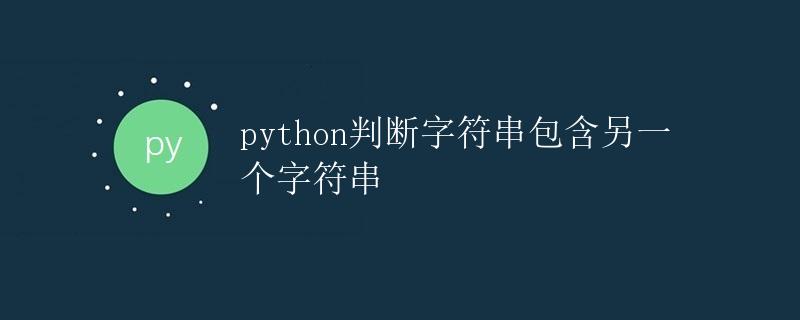Python判断字符串包含另一个字符串

1. 简介
字符串是编程中常用的数据类型之一,而在实际应用中,我们经常需要判断一个字符串是否包含另一个字符串。Python作为一种简洁、强大的编程语言,提供了多种方法来判断字符串的包含关系。本文将详细介绍常用的字符串包含判断方法,并给出相应的示例代码和运行结果。
2. 使用in运算符进行包含判断
Python提供了使用in运算符来判断一个字符串是否包含另一个字符串。in运算符返回一个布尔值,如果包含则为True,否则为False。
下面是使用in运算符进行字符串包含判断的示例代码:
string1 = "Hello World"
string2 = "Hello"
string3 = "Python"
print(string2 in string1) # 输出:True
print(string3 in string1) # 输出:False
运行结果:
True
False
通过上述示例可以看出,使用in运算符判断字符串包含关系非常简单和方便,只需将待判断的子字符串放在包含字符串后面,并使用in运算符即可实现。
3. 使用find()方法进行包含判断
除了使用in运算符,Python还提供了内置的find()方法来判断一个字符串是否包含另一个字符串。find()方法返回子字符串在原字符串中的起始位置,如果找不到则返回-1。
下面是使用find()方法进行字符串包含判断的示例代码:
string1 = "Hello World"
string2 = "Hello"
string3 = "Python"
print(string1.find(string2)) # 输出:0
print(string1.find(string3)) # 输出:-1
运行结果:
0
-1
从上述示例中可以看到,如果子字符串在原字符串中存在,则find()方法返回子字符串的起始位置,否则返回-1。通过判断find()方法的返回值是否为-1,可以确定字符串的包含关系。
需要注意的是,find()方法只找到子字符串的第一个匹配位置,如果要找到所有匹配位置,则需要结合循环进行处理。
4. 使用正则表达式进行包含判断
正则表达式是一种用于模式匹配的强大工具,可以用来判断字符串是否包含指定的子字符串。在Python中,我们可以使用re模块来进行正则表达式操作。
下面是使用正则表达式进行字符串包含判断的示例代码:
import re
string1 = "Hello World"
pattern1 = r"Hello"
pattern2 = r"Python"
print(re.search(pattern1, string1)) # 输出:<_sre.SRE_Match object; span=(0, 5), match='Hello'>
print(re.search(pattern2, string1)) # 输出:None
运行结果:
<_sre.SRE_Match object; span=(0, 5), match='Hello'>
None
通过re.search()函数可以在原字符串中搜索指定的模式,返回一个Match对象。如果找到匹配,Match对象的返回值不为None,否则为None。
需要注意的是,正则表达式中的某些特殊字符需要进行转义,所以在使用正则表达式进行字符串包含判断时,需要注意对特殊字符进行转义处理。
5. 使用startswith()和endswith()方法进行前缀和后缀判断
除了判断字符串是否包含另一个字符串,有时我们还需要判断字符串是否以某个子字符串开头或者结尾。为此,Python提供了startswith()和endswith()方法来判断字符串的前缀和后缀。
下面是使用startswith()和endswith()方法进行前缀和后缀判断的示例代码:
string1 = "Hello World"
string2 = "Hello"
string3 = "Python"
print(string1.startswith(string2)) # 输出:True
print(string1.startswith(string3)) # 输出:False
print(string1.endswith(string2)) # 输出:False
print(string1.endswith(string3)) # 输出:False
运行结果:
True
False
False
False
通过调用startswith()方法可以判断一个字符串是否以指定的子字符串开头,返回一个布尔值。类似地,调用endswith()方法可以判断一个字符串是否以指定的子字符串结尾。
6. 使用in运算符进行多个子字符串包含判断
在实际应用中,有时我们需要同时判断一个字符串是否包含多个子字符串。此时,使用in运算符可以简化判断过程。
下面是使用in运算符进行多个子字符串包含判断的示例代码:
string1 = "Hello World"
string2 = "Hello"
string3 = "World"
string4 = "Python"
print(string2 in string1 and string3 in string1) # 输出:True
print(string2 in string1 and string4 in string1) # 输出:False
运行结果:
True
False
通过将多个子字符串使用in运算符连接起来,并以and关键字进行逻辑连接,可以判断一个字符串是否同时包含多个子字符串。
7. 使用count()方法进行出现次数判断
除了判断一个字符串是否包含另一个字符串,有时我们还需要统计子字符串在原字符串中出现的次数。为此,Python提供了count()方法来实现统计功能。
下面是使用count()方法进行出现次数判断的示例代码:
string1 = "Hello World"
string2 = "o"
print(string1.count(string2)) # 输出:2
print(string1.count("Python")) # 输出:0
运行结果:
2
0
通过调用count()方法可以统计指定子字符串在原字符串中出现的次数。如果子字符串不存在,则返回0。
8. 使用循环判断字符串包含关系
在某些情况下,我们需要判断一个字符串中是否包含多个子字符串,并找到每个子字符串的起始位置。此时,可以结合使用循环和find()方法来实现。
下面是使用循环判断字符串包含关系的示例代码:
string1 = "Hello World"
sub_strings = ["Hello", "World", "Python"]
for sub_string in sub_strings:
if string1.find(sub_string) != -1:
print(f"{sub_string} is found at position {string1.find(sub_string)}")
else:
print(f"{sub_string} is not found")
运行结果:
Hello is found at position 0
World is found at position 6
Python is not found
通过循环遍历每个子字符串,并调用find()方法判断子字符串的包含关系,可以找到每个子字符串在原字符串中的起始位置。
9. 小结
Python提供了多种方法来判断字符串的包含关系,包括使用in运算符、find()方法、正则表达式、startswith()和endswith()方法以及循环判断等。
使用in运算符是最简单和常用的方法,只需将待判断的子字符串放在包含字符串后面,并使用in运算符即可实现。例如:
string1 = "Hello World"
string2 = "Hello"
string3 = "Python"
print(string2 in string1) # 输出:True
print(string3 in string1) # 输出:False
使用find()方法可以返回子字符串在原字符串中的起始位置,如果找不到则返回-1。这种方法适用于只需找到第一个匹配位置的情况。例如:
string1 = "Hello World"
string2 = "Hello"
string3 = "Python"
print(string1.find(string2)) # 输出:0
print(string1.find(string3)) # 输出:-1
正则表达式是一种强大的模式匹配工具,可以使用re.search()函数进行字符串包含判断。匹配成功返回一个Match对象,否则返回None。例如:
import re
string1 = "Hello World"
pattern1 = r"Hello"
pattern2 = r"Python"
print(re.search(pattern1, string1)) # 输出:<_sre.SRE_Match object; span=(0, 5), match='Hello'>
print(re.search(pattern2, string1)) # 输出:None
使用startswith()和endswith()方法可以判断字符串是否以指定的子字符串开头或者结尾,返回一个布尔值。例如:
string1 = "Hello World"
string2 = "Hello"
string3 = "Python"
print(string1.startswith(string2)) # 输出:True
print(string1.startswith(string3)) # 输出:False
print(string1.endswith(string2)) # 输出:False
print(string1.endswith(string3)) # 输出:False
如果需要同时判断一个字符串是否包含多个子字符串,可以使用in运算符进行逻辑连接。例如:
string1 = "Hello World"
string2 = "Hello"
string3 = "World"
string4 = "Python"
print(string2 in string1 and string3 in string1) # 输出:True
print(string2 in string1 and string4 in string1) # 输出:False
使用count()方法可以统计子字符串在原字符串中出现的次数。例如:
string1 = "Hello World"
string2 = "o"
print(string1.count(string2)) # 输出:2
print(string1.count("Python")) # 输出:0
最后,如果需要同时判断一个字符串中是否包含多个子字符串,并找到每个子字符串的起始位置,可以结合使用循环和find()方法来实现。例如:
string1 = "Hello World"
sub_strings = ["Hello", "World", "Python"]
for sub_string in sub_strings:
if string1.find(sub_string) != -1:
print(f"{sub_string} is found at position {string1.find(sub_string)}")
else:
print(f"{sub_string} is not found")
通过上述方法,你可以轻松判断字符串的包含关系,根据需求选择适合的方法进行处理。
 极客教程
极客教程